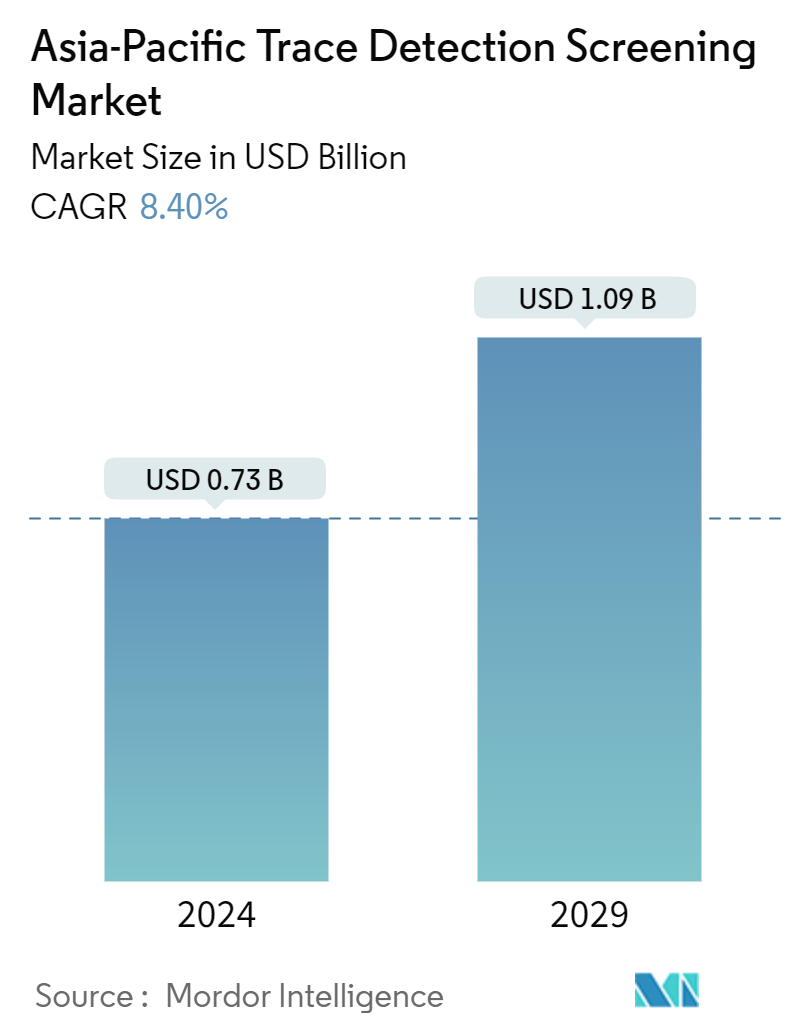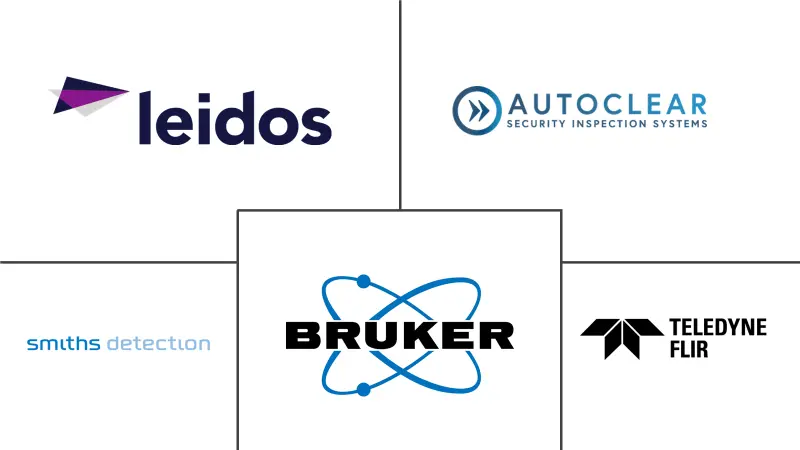Market Size of Asia-Pacific Trace Detection Screening Industry

| Study Period | 2022 - 2029 |
| Base Year For Estimation | 2023 |
| Market Size (2024) | USD 0.73 Billion |
| Market Size (2029) | USD 1.09 Billion |
| CAGR (2024 - 2029) | 8.40 % |
| Market Concentration | Medium |
Major Players
*Disclaimer: Major Players sorted in no particular order |
Asia-Pacific Trace Detection Screening Market Analysis
The Asia-Pacific Trace Detection Screening Market size is estimated at USD 0.73 billion in 2024, and is expected to reach USD 1.09 billion by 2029, growing at a CAGR of 8.40% during the forecast period (2024-2029).
- Trace detection technology is crucial for avoiding emerging threats to airport security. Using trace detection equipment at checkpoints and departure gates helps increase security and keeps the traveling community safe.
- Moreover, explosive trace detection technology is significantly used at boarding areas and checkpoints, where the airport authority conducts screenings. The rising incidents of terrorist activities in the region require airports to adopt trace detectors because airports are places with a large human or financial asset base.
- Also, city officials and the government invest in and deploy centralized security systems, especially trace detection products, to effectively manage security incidents and respond to these situations. The government has always focused on security, including transportation and infrastructure. Explosive trace detection (ETD) technology has long been at the forefront of the fight against terrorism. ETD use is integral to passenger vehicle checkpoints and security screening for various applications.
- During the second wave of the pandemic, FLIR Systems Inc. announced the launch of the FLIR Fido X4, the latest, most advanced version of its premium handheld explosives trace detector. The Fido X4 provides unmatched sensitivity for various explosives, so users can efficiently detect threats at levels other devices cannot.
- FLIR Systems' TrueTrace detection technology features a unique five-channel sensor array that delivers expanded threat coverage. TrueTrace can detect various explosives at nanogram to sub-nanogram levels, including commercial and homemade explosives. It allows users to gain actionable intelligence by identifying threats in as little as 10 seconds.
- Other notable factors influencing the market's growth include recent geopolitical issues, especially the US-China trade dispute and the Russia-Ukraine war. Due to the escalation of disagreement among both countries, the United States has imposed several sanctions on China, preventing them from getting easy access to advanced technologies, especially in manufacturing. Such trends may influence the growth of the country's market.
Asia-Pacific Trace Detection Screening Industry Segmentation
Trace detection is the detection or identification of minute or trace amounts of a substance or material. It involves collecting samples from surfaces, objects, or the environment and analyzing them, then using specialized equipment or methods to detect the target substance at very low concentrations.
The Asia-Pacific trace detection market is segmented by type (explosive and narcotics), product (handheld, portable/movable, and fixed), end-user industry (commercial, military and defense, law enforcement, ports, and borders, public safety, and other end-user industries), and country (China, India, Japan, South Korea, and Rest of Asia-Pacific). The report offers the market size and forecasts for all the above segments in value (USD).
| By Type | |
| Explosive | |
| Narcotics |
| By Product | |
| Handheld | |
| Portable/Movable | |
| Fixed |
| End-user Industry | |
| Commercial | |
| Military and Defense | |
| Law Enforcement | |
| Ports and Borders | |
| Public Safety | |
| Other End-user Industries |
| By Country | |
| China | |
| India | |
| Japan | |
| South Korea | |
| Australia and New Zealand |
Asia-Pacific Trace Detection Screening Market Size Summary
The Asia-Pacific trace detection screening market is poised for significant growth, driven by increasing security concerns and the need for advanced safety measures in various sectors. This market is characterized by the adoption of trace detection technology, which plays a crucial role in enhancing security at airports, government buildings, and other high-risk areas. The technology is essential for detecting explosives and preventing potential threats, especially in regions experiencing geopolitical tensions and rising terrorist activities. The market is semi-consolidated, with key players like Thruvision Ltd, Linev Systems, Evovl Technologies, and Smith Detection leading the charge in innovation and product development. These companies are focusing on leveraging their technological expertise to address complex security challenges and expand their market presence.
The demand for trace detection screening is further fueled by the increasing incidents of bomb threats and the need for robust security measures in public spaces. Governments and private enterprises are investing heavily in centralized security systems, including explosive trace detection products, to safeguard personnel and infrastructure. The market is also influenced by recent geopolitical issues, such as the US-China trade dispute and the Russia-Ukraine war, which have impacted access to advanced technologies. Innovations like FLIR Systems' TrueTrace and Smiths Detection's HI-SCAN 7555 DV are setting new standards in threat detection, offering enhanced sensitivity and automated detection capabilities. As the region continues to face security challenges, the trace detection screening market is expected to experience sustained growth, with a focus on developing advanced solutions to counter emerging threats.
Asia-Pacific Trace Detection Screening Market Size - Table of Contents
-
1. MARKET INSIGHTS
-
1.1 Market Overview
-
1.2 Technology Snapshot
-
1.3 Industry Value Chain Analysis
-
1.4 Industry Attractiveness - Porter's Five Forces Analysis
-
1.4.1 Threat of New Entrants
-
1.4.2 Bargaining Power of Buyers/Consumers
-
1.4.3 Bargaining Power of Suppliers
-
1.4.4 Threat of Substitute Products
-
1.4.5 Intensity of Competitive Rivalry
-
-
1.5 Impact of COVID-19 Aftereffects and Other Macroeconomic Factors on the Market
-
-
2. MARKET SEGMENTATION
-
2.1 By Type
-
2.1.1 Explosive
-
2.1.2 Narcotics
-
-
2.2 By Product
-
2.2.1 Handheld
-
2.2.2 Portable/Movable
-
2.2.3 Fixed
-
-
2.3 End-user Industry
-
2.3.1 Commercial
-
2.3.2 Military and Defense
-
2.3.3 Law Enforcement
-
2.3.4 Ports and Borders
-
2.3.5 Public Safety
-
2.3.6 Other End-user Industries
-
-
2.4 By Country
-
2.4.1 China
-
2.4.2 India
-
2.4.3 Japan
-
2.4.4 South Korea
-
2.4.5 Australia and New Zealand
-
-
Asia-Pacific Trace Detection Screening Market Size FAQs
How big is the Asia-Pacific Trace Detection Screening Market?
The Asia-Pacific Trace Detection Screening Market size is expected to reach USD 0.73 billion in 2024 and grow at a CAGR of 8.40% to reach USD 1.09 billion by 2029.
What is the current Asia-Pacific Trace Detection Screening Market size?
In 2024, the Asia-Pacific Trace Detection Screening Market size is expected to reach USD 0.73 billion.

